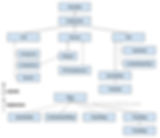Data Structures and Collections in Java
- Satheesh K
- Mar 14, 2024
- 2 min read
Data Structures in Java refer to the systematic ways of organizing, storing, and managing data within a computer program. These structures enable efficient operations like insertion, deletion, retrieval, and traversal. Some common data structures in Java include:
Arrays: A fixed-size collection of elements of the same type. int[] numbers = { 1, 2, 3, 4, 5 };
ArrayList: A dynamic array that can grow or shrink. import java.util.ArrayList; // ... ArrayList<String> names = new ArrayList<>(); names.add("Alice"); names.add("Bob");
LinkedList: A linear data structure where elements are connected via pointers. import java.util.LinkedList; // ... LinkedList<Integer> linkedList = new LinkedList<>(); linkedList.add(10); linkedList.add(20);
Stack: A last-in, first-out (LIFO) structure. import java.util.Stack; // ... Stack<Character> stack = new Stack<>(); stack.push('A'); stack.push('B');
Queue: A first-in, first-out (FIFO) structure. import java.util.Queue; import java.util.LinkedList; // ... Queue<String> queue = new LinkedList<>(); queue.add("Apple"); queue.add("Banana");
HashMap: A key-value pair data structure. import java.util.HashMap; // ... HashMap<String, Integer> ages = new HashMap<>(); ages.put("Alice", 30); ages.put("Bob", 25);
HashSet: A set of unique elements. import java.util.HashSet; // ... HashSet<String> uniqueNames = new HashSet<>(); uniqueNames.add("Alice"); uniqueNames.add("Bob");
TreeMap: A sorted map based on a binary search tree. import java.util.TreeMap; // ... TreeMap<Integer, String> sortedMap = new TreeMap<>(); sortedMap.put(3, "C"); sortedMap.put(1, "A");
Graph: A non-linear data structure with vertices and edges.
Trie: A prefix tree for efficient string matching.
These data structures empower Java developers to optimize memory usage and enhance program efficiency - Content courtesy to javatpoint.com
A collection is a higher-level concept in Java that builds upon data structures.
The Java Collections Framework (JCF) offers a rich set of pre-built collection implementations like ArrayList, LinkedList, HashSet, HashMap, etc.
These collections are built on underlying data structures (e.g., ArrayList uses an array internally).
Pic courtesy to beginnersBook.coom. Please follow the link for examples - Collections in Java with Example Programs (beginnersbook.com)
Here's an analogy:
Think of a data structure as a filing cabinet. It defines how folders and documents are physically organized within the cabinet.
A collection is like a set of labels you stick on the folders. These labels (the JCF interface) provide a standard way to access and manage the documents (objects) inside the cabinet (data structure).
Here's a table summarizing the key differences:
Feature | Data Structure | Collection |
Focus | How data is organized in memory | How to access and manipulate groups of objects |
Interface | No standard interface | Provides a standard interface (methods) |
Implementation | Can be custom-built or use built-in options | Pre-built implementations in Java Collections Framework (JCF) |
Example | Array, Linked List, Stack, Queue, Tree, Graph | ArrayList, LinkedList, HashSet, HashMap, etc. |
In essence:
Data structures are the building blocks for efficient data organization.
Collections provide a standardized way to work with these data structures in Java.
Content courtesy to gemini.google.com and bing.com
